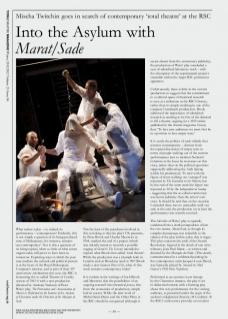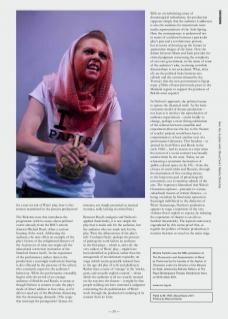What makes a play – or, indeed, its performance – contemporary? Evidently, this is not simply a question of its being produced now, if Shakespeare, for instance, remains ‘our contemporary’. Nor is this a question of its being topical, when so little of what seems urgent today will prove to have been so tomorrow. Exploring ways in which the past may mediate the cultural and political present is at the heart of the Royal Shakespeare Company’s mission, and as part of their 50th anniversary celebrations this year, the RSC is honouring the so-called Theatre of Cruelty season of 1963-4 with a new production (directed by Anthony Neilson) of Peter Weiss’ play, The Persecution and Assassination of Marat as Performed by the Inmates of the Asylum of Charenton under the Direction of the Marquis de Sade.
Not the least of the paradoxes involved in this revisiting is that the play’s UK premiere, by Peter Brook and Charles Marowitz in 1964, marked the end of a project (which was initially meant to research a possible staging of Genet’s The Screens) intended to explore what Brook then called ‘total theatre’. While the production was a triumph both in London and on Broadway (and in 1967 Brook made a now famous film of it), what of this work remains contemporary today?
It is evident in the writings of both Brook and Marowitz that the possibilities of an ongoing research into theatrical process, free from the economics of production, simply had its season. While the later work of Michel Saint-Denis and the Other Place at the RSC should be recognised (although it seems absent from the anniversary publicity), the production of Weiss’ play concluded a year of subsidised laboratory work – with the absorption of the experimental project’s ensemble within the larger RSC production apparatus.
Unfortunately, there is little in the current production to suggest that the commitment to a cultural space of theatrical research is seen as a milestone in the RSC’s history, rather than its simply resulting in one of the company’s landmark productions. Brook addressed the importance of subsidised research as needing to be free of the demand to fill a theatre, arguing (in a 1959 article published in the theatre magazine Encore) that: ‘To face new audiences we must first be in a position to face empty seats.’
It is surely the politics of such subsidy that remains contemporary – distinct from the topical discussion of empty seats in terms of people walking out of the current performances (not to mention Neilson’s irritation at the focus by reviewers on this story, rather than on the political questions supposedly addressing the Arab Spring within his production). To start with the figure of those walking out ‘outraged’ was reported in The Guardian to be fifteen, but by the end of the same week the figure was reported as 30 by the Independent on Sunday – suggesting that the so-called controversy was better publicity than the artists’ own story. It should be said that on the occasion I attended there was no noticeable walk out and, at the end, the production (or at least the performance) was warmly received.
The full title of Weiss’ play is typically condensed into a stark juxtaposition of just the two names, Marat/Sade, as though its complex dramaturgy was reducible to the subject of the play within a play that it stages. This play concerns the ends of the French Revolution, figured in the death of one of its tribunes, Jean-Paul Marat – as written and directed by the Marquis de Sade. (This death, commemorated in a celebrated painting by the contemporary artist Jacques-Louis David, was famously played by Artaud in Abel Gance’s 1926 film Napoleon.)
Performed as an exercise in art therapy by the Charenton inmates, the play is set in dialectical tension with a framing play about this very performance for the visiting audience, as presented under the aegis of the asylum’s enlightened director, M Coulmier. If the RSC’s anniversary provides an occasion for a rare revival of Weiss’ play, how is this tension manifested in the present production?
The Welcome note that introduces the programme (with its essays about political events abroad), from the RSC’s artistic director Michael Boyd, offers a curious framing of the work. Addressing the audience, the note offers an example of the play’s fiction of the enlightened director of the Asylum (or of what one might call the educational correction institution of the Stratford theatre itself). In the experience of the performance (rather than in the production) a seemingly inadvertent framing is also effected by the presence of the ushers, who constantly supervise the audience’s behaviour. While the performance ostensibly begins with the arrival of an onstage audience of Sheikhs and Royals, it seems as though Neilson is content to take the play’s mode of direct address at face value, as if it did not need any of the Brechtian distancing that the dramaturgy demands. (The songs that interrupt the protagonists’ drama, for instance, are simply presented as musical routines, sadly lacking in critical bite.)
Between Boyd’s analgesic and Neilson’s applied theatricality, it is not simply the play that is made safe for the audience, but the audience who are made safe for the play. Were the abbreviation of the play’s title ‘Coulmier/Sade’, perhaps the process of putting the work before an audience in the first place – which is, after all, the very subject of Weiss’ play – might have been identified as political, rather than the masquerade of revolutionary topicality on stage (which seems generally reduced here to the age-old play of veils and phalluses). Rather than a sense of ‘outrage’ at the ‘smoke, guns, and sexually explicit content’ – about which the audience is all too wearily warned on the way into the theatre – it might be that people walking out have exercised a judgment concerning the de-politicisation of Weiss’ work through the production’s isolating of its content from its form.
With an overwhelming sense of dramaturgical redundancy, the production supposes simply that the audience it addresses is also the audience for mainstream news media representations of the Arab Spring. Here the contemporary is understood not in terms of a relation between a particular play’s past and a revolutionary present, but in terms of dressing up the former in pantomime images of the latter. How the debate between Marat and Sade provides for critical judgment concerning the complicity of our own government, in the name of some of the audience’s jobs, in arming erstwhile dictatorships is not articulated. What, after all, are the political links between arts subsidy and the current demand by the Treasury that the new government in Egypt repay £100m of loans previously given to the Mubarak regime to support the purchase of British arms exports?
In Neilson’s approach, the political seems to ignore the theatrical itself. As the basic economic model of theatre production – not least as it involves the reproduction of audience expectations – seems hardly to change, perhaps a more fitting celebration of the relation between ensemble and experiment (that was the key to the ‘theatre of cruelty’ project) would have been a commitment to at least another year of a performance laboratory. This freedom – as posited by both Weiss and Brook in the early 1960s – had its season at a time when the notion of a social contract was broadly underwritten by the state. Today, we are witnessing a systematic destruction of public cultural space in the UK – from the closure of youth clubs and libraries, through the decimation of free evening classes, to the long-term goal of privatising the universities, not to mention subsidy of the arts. The ‘repressive liberalism’ that Weiss’s Charenton explores – precisely in a (statesubsidised) theatre of critical distance – is being overtaken by libertarian repression. Seemingly indifferent to the dialectics of Weiss’ dramaturgy, Neilson’s production appears to stage a repetition of the very violence that it aspires to expose, by reducing the experience of theatre to an all too familiar theatricality. The topical controversy engendered by this seems proof that, as regards the politics of theatre production, it remains business as usual on the main stage.
Mischa Twitchin saw the RSC production of The Persecution and Assassination of Marat as Performed by the Inmates of the Asylum of Charenton under the Direction of the Marquis de Sade, directed by Anthony Neilson, at The Royal Shakespeare Theatre, Stratford-on-Avon, on 29 October 2011.
www.rsc.org.uk


